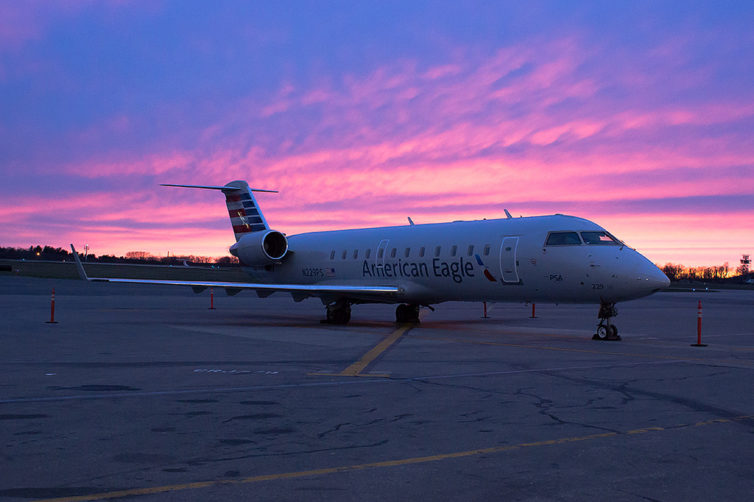It didn’t take me long to agree to work as Press for PAX East (if you’re not sure what that is, check the link ahead). After last year’s adventure in San Antonio for PAX South, I was eager to experience the last major PAX event that I hadn’t yet been to. Besides, I’d never visited Boston before.
American, Delta, United, Frontier, and Allegiant all operate flights out of my local airport, either directly or through a regional subcontract. While I prefer to fly Delta, they were significantly more expensive than American for an early April round trip to Boston. Neither Frontier nor Allegiant fly into Boston’s Logan International, which put them out of the running. American it was! Given that I expected to come back from Boston with two checked bags plus a carryon, a back-to-front (Economy to Boston, First Class home) flight plan almost paid for itself in bag fees. At least, as long as I didn’t mind flying Boston to Sioux Falls via Charlotte and Chicago.
Unlike Delta, which runs its FSD-MSP feeder flights on mainline A320 or B717 aircraft, American contracts with Air Wisconsin to feed their Chicago-O’Hare hub with CRJ-200 flights. These aircraft are all single class 2-2 configuration. As I would find out, no booking consideration is given to First Class on other legs. Anyone wanting one of the few prefered seats on the -200 is going to have to pay for it.
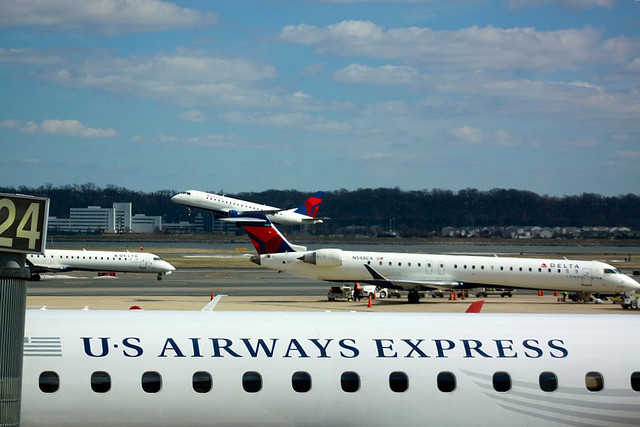
There are going to be a lot more Delta widgets seen at LGA soon.
Recently, Delta Air Lines announced their game plan to expand at LaGuardia Airport (LGA) after their slot swap with US Airways. Delta, being the world’s second largest airline, has plenty that they can bring to the New York area and grow LGA into a major hub for business travelers.
If you scroll through the new Delta LGA flights, you will see a lot of smaller aircraft: the Embraer ERJ-145, E-170, E-175, Bombardier CRJ-700, CRJ-900 and the CRJ-200. With an airport that is already so crowded, it was a little surprising seeing so many small aircraft.
Just because a new route starts as a smaller aircraft, doesn’t mean that Delta can’t upgrade to a larger aircraft later. Still, it seems like some of the routes might be able to handle larger aircraft, why did Delta go this route?
“It’s purely a function of having the right aircraft for the right market,” Morgan Durrant, Delta Spokesperson explained to AirlineReporter.com. “LaGuardia is arguably the most restricted airfield in the world but that doesn’t preclude the market demand for both capacity and frequency. Utilizing regional aircraft in some markets allows us to achieve both in a way that’s good for customers and good for business.”
At least Delta is operating jets; US Airways Express (aka Piedmont) flew quite a few turbo-props in LGA. For the airline nerd (that many of us probably are), turbo-props are fun to fly in, but I know that most travelers do not share our passion for aviation and most prefer the comfort of a jet. And remember, that not all regional jets are created equally. Many of Delta’s jets that have more the 50 seats contain amenities found on larger aircraft.
“Delta Connection aircraft larger than 50 seats will have a two-cabin configuration and Gogo Wi-Fi,” Durrant stated.
Delta has more connections and are arguably using better aircraft, so I wouldn’t be surprised if they are able to become quite successful out of LGA. I also wouldn’t be surprised to start seeing larger planes operating in Delta colors in the future out of LaGuardia as well.
Two view points you have to read about this topic are: Brett Snyder looking at the winners and losers of this deal and Dan Webb looking at the new destinations.
Photo by: Jerome Vorus
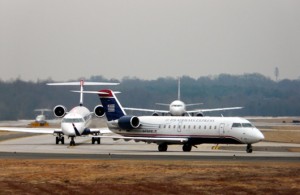
US Airways Express (PSA) CRJ 200 on the taxiway followed by ’œCompany Traffic’ CRJ 700
When passion, creativity, photography and the ability to write combine with fans, I love to share their work. This is a blog written by Andrew Vane for Airline Reporter taking a close look at Bombardier’s CRJs:
Canadian company Bombardier Aerospace acquired government-owned Canadair Ltd and entered the regional jet market in the 1980’s. Today the most commonly seen and flown CRJ’s consist of the CRJ-200 (50 seats), CRJ 700 (75 seats) and CRJ900 (90 seats). CRJ’s are most popular amongst the major airline’s subsidiaries for shorter domestic flights between hubs and along spokes. Here in Charlotte (KCLT), virtually all of Terminal E is occupied by gates to serve regional jets and turboprops. Similarly, in Cincinnati/Northern Kentucky Airport (KCVG), Delta dedicated a major portion of the largest terminal to their regional jet carrier Comair.
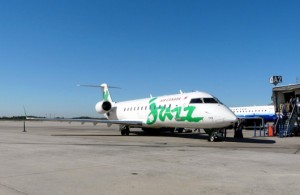
No this ain’t headed for New Orleans. It’s an Air Canada Jazz CRJ 200 bound for the Great White North.
The CRJ 200 is an upgrade to its -100 predecessor with the addition of more efficient engines coming in Extended Range (ER) and Long Range (LR) versions. Guess which one is longer? Answer: Without consulting Bombardier’s data, your guess is as good as mine. (Per the web site the range of the ER is about 1,800 miles and the LR version is 2,300 miles.) CRJ 100/200’s are most common domestically among the major airliner’s regional carriers Comair, Skywest, ASA, Air Canada, MESA, US Airways Express (PSA), Skywest and Republic.
First entering service in 2001, the CRJ 700 series provided a bit more seats and comparable range to the LR version of the CRJ 200. In profile, the easiest way to tell the difference between a -200 and -700 is the fact that the -700 is longer and the rear end is sticking up in the air. In addition to more seating, the CRJ700 features a new wing with leading edge slats and a stretched and slightly widened fuselage, with a lowered floor. CRJ 700’s are most frequently flown in the US by Air Canada Jazz, American Eagle, ASA, Comair, Horizon Air, Mesa, Skywest, and US Airways Express (PSA). A further refinement of the CRJ 700 was the CRJ 705 series, operated by Air Canada, which added 75 seats and split the aircraft into business and economy classes of 10 and 65 seats, respectively. Only sixteen 705’s were built.
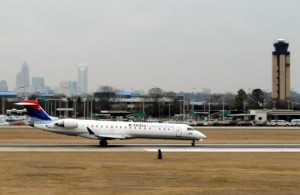
ASA ’œAcey’ CRJ 700 rolling on 18C at Charlotte-Douglas International Airport.
Eventually, this French Canadian company, who also produces the popular Dash-8 family of turboprops, expanded the CRJ fleet design to include a longer -900 version. The CRJ 900 features a ’œcomplete re-design of all of the structure and systems. In addition, an all-new wing was developed that increases the cruise speed of these aircraft while offering excellent airfield characteristics. These aircraft also feature an all new interior cabin that offers increased room for the passenger, enabled by a lowering the floor by 1’ (2.54 cm) and redesigning the aircraft frame RJ900 that featured as of the original CRJ200, offering more headroom and a wider cabin. The seating and bins were completely redesigned to allow more passenger space and increased bin stowage,’ says Bombardier’s web site. CRJ 900’s are currently operated by Mesa Air, Air Canada Jazz, Skywest, Comair and Pinnacle Airlines.
From my own personal experience, I was a bit disappointed with the window placing and height for my 6-foot tall frame. I ended up with a neck ache each time I sat by a window. The windows are much lower compared to Bombardier’s Brazilian competitor, Embraer.
Some airlines have planned a future full of regional jets in lieu of larger aircraft with empty seats. Smaller aircraft lower to the ground provide easier boarding in variable conditions (jetway or stairs). With over 700 CRJ’s of all versions delivered by Bombardier in the last 30 years, chances are you’ll be riding in one of these the next time you fly out of a small city.
Bombardier’s CRJ story here.
Images: All photos by Andrew Vane
